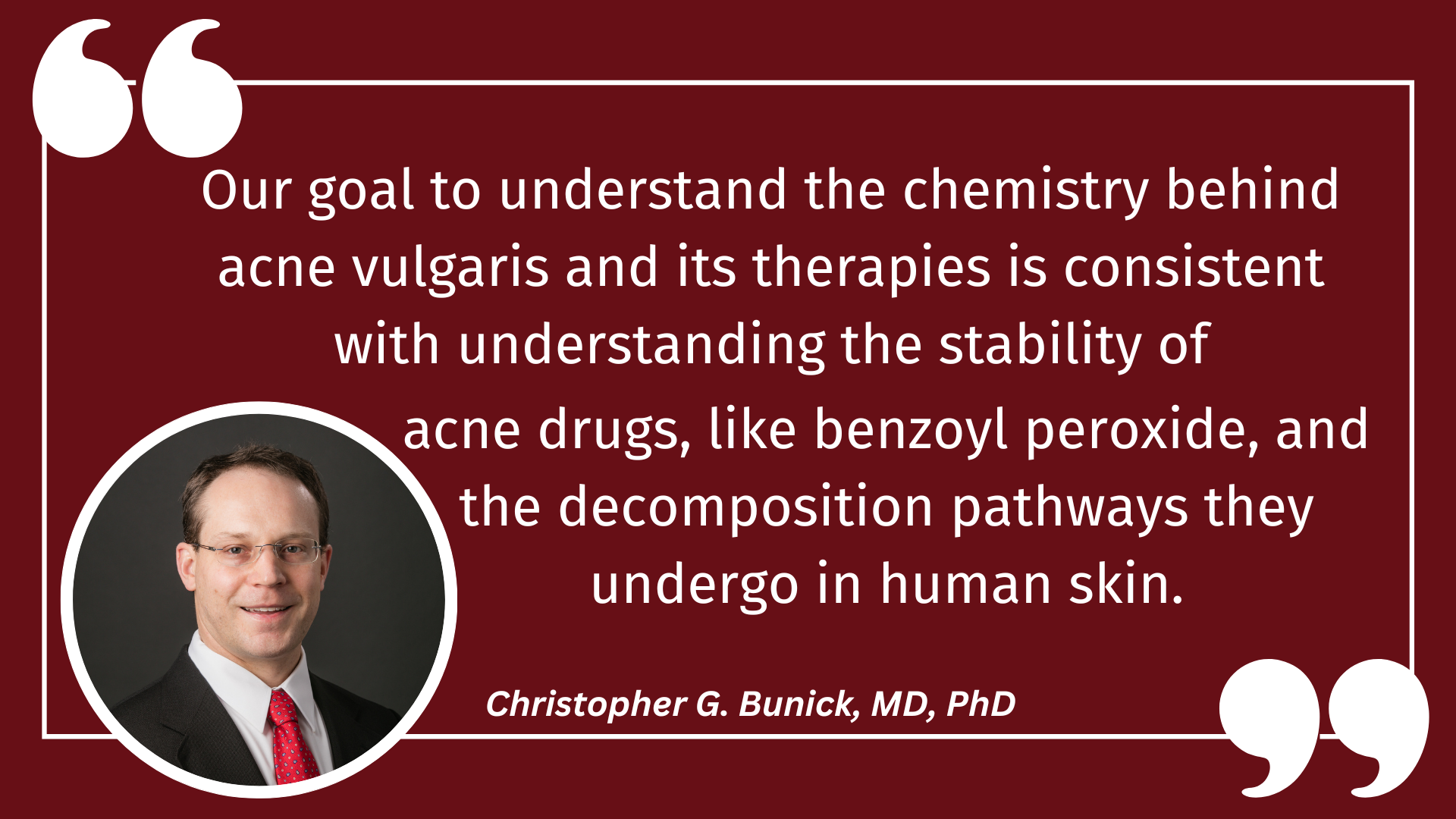- Case-Based Roundtable
- General Dermatology
- Eczema
- Chronic Hand Eczema
- Alopecia
- Aesthetics
- Vitiligo
- COVID-19
- Actinic Keratosis
- Precision Medicine and Biologics
- Rare Disease
- Wound Care
- Rosacea
- Psoriasis
- Psoriatic Arthritis
- Atopic Dermatitis
- Melasma
- NP and PA
- Skin Cancer
- Hidradenitis Suppurativa
- Drug Watch
- Pigmentary Disorders
- Acne
- Pediatric Dermatology
- Practice Management
- Prurigo Nodularis
- Buy-and-Bill
News
Article
Dermatology Times
BREAKING NEWS: Additional Study Confirms Reports of Benzene Presence, Formation in Benzoyl Peroxide Products at Room Temperature
Key Takeaways
- Benzene contamination in BPO products is significant, with 34% exceeding FDA's 2 ppm limit, influenced by formulation, heat, and UV exposure.
- Cold storage stabilizes BPO, reducing benzene formation, supporting American Acne and Rosacea Society's recommendations.
New peer-reviewed research published in the Journal of Investigative Dermatology examined 111 products at room temperature.

New research published in the Journal of Investigative Dermatology (JID) confirms findings of benzene presence and formation in benzoyl peroxide (BPO) drug and acne products—this time, with testing conducted at room temperature.1,2
The latest round of benzene news follows the initial detection of high levels of benzene found in certain BPO-containing acne products announced on March 6, 2024. With the first detection of benzene, Valisure, LLC, an independent testing laboratory, filed a petition with the FDA requesting a recall of products affected by the elevated levels of benzene to allow regulators to investigate.3
The new study reports that "111 BPO drug products tested from major US retailers appear to be substantially contaminated with benzene when tested shortly after being acquired off the shelf."1
Researchers acquired BPO products from major retail stores in several US states, conducting sampling in California, Connecticut, Florida, Illinois, New York, and Texas. Galderma Epsolay Benzoyl Peroxide Cream was used for incubation experiments at varying temperatures. Researchers utilized gas chromatography-mass spectrometry (GC-MS) to detect benzene levels, while selected ion flow tube-mass spectrometry tracked benzene release.
Results demonstrated that 34% of the products, equivalent to 38 products, contained benzene levels above the FDA's 2 parts per million (ppm) limit, with concentrations ranging from 0.16 ppm to 35.30 ppm.
"The Bunick lab has been actively investigating acne vulgaris for over 5 years, with special emphasis on elucidating the biochemical and structural mechanisms of action of dermatologic antibiotics (e.g. tetracyclines, clindamycin) on the Cutibacterium acnes ribosome. Our goal to understand the chemistry behind acne vulgaris and its therapies is consistent with understanding the stability of acne drugs, like benzoyl peroxide, and the decomposition pathways they undergo in human skin," said Christopher Bunick, MD, PhD, study author, associate professor of dermatology and translational biomedicine at Yale University School of Medicine in New Haven, Connecticut, and Dermatology Times’ 2024 Winter Editor in Chief, in an exclusive statement to Dermatology Times.

The source and age of the products did not significantly affect benzene levels. Additionally, heat and UV exposure, particularly sunlight, accelerated benzene formation, raising concerns about product degradation.
During UV testing, it was found that approximately 4.36 ppm of benzene was generated in the chamber per hour of UVA/B exposure.
"The results of the products sampled in this study suggest that formulation is likely the strongest contributor to benzene concentrations in BPO drug products that are commercially available, since the magnitude of benzene detected correlates most closely with specific brands or product types within certain brands," wrote the authors of the JID study.
Additionally, the study authors used cold temperature incubation to test the Epsolay BPO product and confirmed their expectation that cold storage stabilizes BPO formulation, supporting the previous recommendations of the American Acne and Rosacea Society.
When the Epsolay BPO product was incubated at 50°C, benzene formed linearly over time. Based on the data, approximately 9 ppm of benzene formed per day of incubation and the concentration of benzene in the product reached 2 ppm within approximately 5 hours of incubation at 50°C. After 2 weeks of incubation at 50°C, the product had 130 ppm of benzene.
Table. Benzene concentration measured in 2 BPO drug product samples where the GC-MS oven incubation time was varied to 10, 20, 40, and 60 minutes, all at 37°C
Source: Journal of Investigative Dermatology

To determine whether the altered environment of the BPO drug product that is dissolved in dimethyl sulfoxide would have a meaningful effect during the 20-minute 37°C GC-MS headspace equilibration period, an experiment was conducted where GC-MS headspace equilibration time was varied between 10 and 60 minutes. The results of 2 different test products (Clearasil Stubborn Acne Control 5 in 1 Spot Treatment Cream and Proactiv Renewing Cleanser) suggest that there is no substantive effect on benzene concentration from the 20-minute 37°C GC-MS headspace equilibration.
In the initial March 2024 report, Valisure tested 66 BPO products including creams, lotions, gels, and washes that are available over the counter from main retailers or in prescription form. Valisure's testing found high levels of benzene when BPO products were incubated at 37°C (98.6°F: standard body temperature), 50°C (122°F: accepted pharmaceutical stability testing temperature), and 70°C (158°F: transportation or passenger vehicle temperature).
Among the 66 products, Valisure found that some products contained up to 12 times the "allowed" amount of 2 parts per million of benzene. Overall, Valisure found that Proactiv's 2.5% BPO cream contained 1761 parts per million of benzene; Target's Up & Up 2.5% BPO cream had 1598 parts per million; Estee Lauder's Clinique 2.5% BPO cream had 401 parts per million; Reckitt Benckiser Group's Clearasil 10% BPO cream had 308 parts per million, and Walgreens 10% BPO cream had 114 parts per million, as some of the products with the highest parts per million.
Read more from Dermatology Times.
A research letter published on March 14, 2024, in Environmental Health Perspectives further examined the testing methods used in March 2024 to detect benzene found in BPO-containing acne products.4
Although the FDA conditionally “allows” 2 parts per million of benzene in drug products, there is truly no safe level of benzene. According to Kucera et al, the FDA specifies that no drug products should contain benzene due to its toxicity, but that 2 ppm is acceptable only for products that absolutely require benzene for manufacturing. Although the stability studies focused on the development of benzene over time, the “Day 0” values represented the baseline concentration of benzene in the products before incubation or any exposure to elevated temperatures. Of the 71 stability-tested products in both studies, 24 products had starting benzene concentrations over 2 ppm and 11 products were over 10 ppm.2,4
"The discovery of benzene formation in benzoyl peroxide acne treatments presents a potentially serious public health risk," said David Light, in a news release from Valisure.5
"Our research demonstrates that these products, widely used by consumers of all ages, can potentially contain or generate concerningly high levels of benzene, particularly under common environmental conditions. This issue highlights the critical importance of rigorous independent testing of drug products to help protect consumers from harmful contaminants," Light said.
The potential health risks associated with benzene formation in BPO products emphasize the urgent need for further precautions and understanding. As Bunick explained to Dermatology Times, those with concerns should start by reviewing the primary research before implementing practical steps to reduce exposure.
"For colleagues with questions or concerns, I encourage them first to read carefully the primary research articles," Bunick told Dermatology Times. "Then, the single most immediate step they could take to mitigate concerns about using benzoyl peroxide products or patient fears is to encourage refrigeration of the medicine at all times, replace the medicine every ~ 12 weeks, and avoid storage in or near heat and sunlight."
References
- Edney A. Second study finds cancer risk in Proactiv, Clearasil and other acne creams. Bloomberg. October 7, 2024. Accessed October 7, 2024. https://www.bloomberg.com/news/articles/2024-10-07/proactive-clearasil-contain-cancer-risk-second-study-finds?srnd=undefined&leadSource=uverify%20wall
- Kucera K, Zenzola N, Hudspeth A, et al. Evaluation of benzene presence and formation in benzoyl peroxide drug products. J Invest Dermatol. October 7, 2024. https://www.jidonline.org/article/S0022-202X(24)02155-9/fulltext
- Valisure citizen petition on benzene in benzoyl peroxide drug products. Valisure. March 5, 2024. Accessed October 7, 2024. https://assets-global.website-files.com/6215052733f8bb8fea016220/65e8560962ed23f744902a7b_Valisure%20Citizen%20Petition%20on%20Benzene%20in%20Benzoyl%20Peroxide%20Drug%20Products.pdf
- Testing methods: Kucera K, Zenzola N, Hudspeth A, et al. Benzoyl peroxide drug products form benzene. Environ Health Perspect. 2024;132(3):37702. doi:10.1289/EHP13984
- Top dermatology journal publishes new Valisure research on benzene presence and formation in benzoyl peroxide drug products. Valisure. October 7, 2024. Accessed October 7, 2024. https://www.valisure.com/valisure-newsroom/new-valisure-scientific-paper-on-benzene-in-benzoyl-peroxide-products






